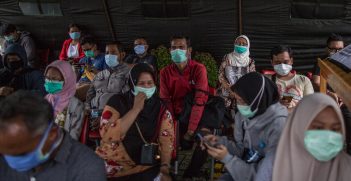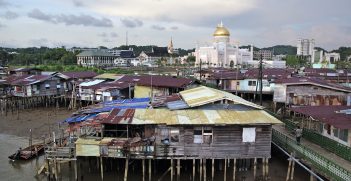Post-COVID-19 Economy, Geopolitical Shifts, and the Distortion of PPPs in Southeast Asia

https://t.ly/cBBQ3Public-Private Partnerships (PPPs) have been long lauded as a viable financing alternative for Southeast Asian countries to fill in infrastructure gaps and boost economic growth. The changing geopolitical landscape and development priorities particularly since the COVID-19 pandemic, however, have distorted PPP implementation and opened them up to predatory domestic interests—Indonesia being a case in point.
Prior to COVID-19 in Southeast Asia it became apparent that investment in infrastructure had become a prominent feature of national development agendas. Having been inspired by the developmental model of China’s success echoed through the Belt and Road Initiative (BRI), country leaders readily projected physical infrastructure—railway, toll, ports, and power plants—as a prerequisite for economic growth and prosperity. Central to this has been a strong push in the region for Public Private Partnerships (PPPs) as a viable financing alternative to spread risk and “unlock” the potential of the private sector.
In 2019, Vietnam tabled a draft law on PPPs as a testament to the government’s efforts in creating a transparent legal framework and attracting greater private sector involvement in the infrastructure space. Former Philippine president Rodrigo Duterte, through his “Build Build Build” program, also vowed to pick up the development pace with PPP projects. Similarly, Indonesian President Joko Widodo (Jokowi) placed PPPs as a solution for accelerating infrastructure development in Indonesia. His first presidential term has seen the deliberation of legislative tools and policy instruments, such as an annually issued PPP Book, presidential regulations on National Strategic Projects (PSNs), and relevant ministerial regulations to support the implementation of PPPs. Likewise, PPPs have been lauded as a new concept for development cooperation between Southeast Asian countries and their long-standing development partners such as Japan and Australia—beyond overseas development assistance (ODA) and technical assistance. Australia, for example, has set up the Partnership for Infrastructure (P4I) to promote regional resilience through infrastructure partnerships with Southeast Asian countries and advises on PPPs to bridge infrastructure gaps.
Nonetheless, prompted by the COVID-19 recession, Southeast Asia’s policymakers have shifted development priorities, such as to EV-centric industrialisation, while the hype surrounding PPPs has been waning. In tandem with China’s economic slowdown, several BRI-tagged PPP projects have failed to materialise. However, it should not be assumed that PPPs no longer carry weight in the development regime of Southeast Asian states. In Indonesia specifically, its post-COVID-19 economy illustrates how PPPs have increasingly become a loosely defined financing scheme through which wide-ranging projects could be squarely fitted. PPPs have been operating in various other economic domains featuring deep-seated predatory political and corporate elites—who have long characterised Indonesia’s political economy.
PPPs in Indonesia: Selective implementation, blurred interests
Of Jokowi’s long list of PPP infrastructure projects, although having drawn much interest from domestic and foreign investors, many have failed to materialise. Real investment has yet to significantly make its way to sectors normally thought of as strategic, such as port operations and railway networks. Showcase projects, so far, have centered around either state-owned enterprise-led toll-roads or coal power plants developed under the Independent Power Producer (IPP) scheme, which have extended the interests of extractive conglomerates and their foreign partners. Here, the scheme has convinced the private sector that revenues will exceed costs thanks to a power purchase agreement with Indonesia’s state-owned electricity company (PLN), whereby tariffs are locked in for 25 years.
Democratic demands for improved social housing and public works have been settled in favour of predatory elites. From relatively early on in Indonesia’s democratic era, initiatives to increase the supply for low-cost apartments in increasingly congested Indonesian cities like Jakarta became hijacked by developers looking to build luxury apartments in prime locations. Developers in the capital have been able to exceed limits on permitted floor area ratios and build to their desired verticality, if they compensate the city with upgrading public works or constructing social housing. More recent political attempts to steer developers’ interests toward achieving state development goals have been highly contextual and have blurred motivations. The current construction of the Kamal-Teluknaga-Rajeg toll road, for instance, is a Public Works and Housing Ministry project that was listed as “KPBU” (Indonesian acronym for PPP) and sought a financing guarantee from the Indonesia Infrastructure Guarantee Fund (IIGF) in 2022. The project is in fact an unsolicited proposal from PT Duta Graha Karya, a private consortium comprising of Agung Sedayu Group and Salim Group. While the toll road is purported to increase connectivity for manufacturing and service sectors in the area, it does also conveniently service a 6,000-hectare megaproject township, Pantai Indah Kapuk (PIK) 2, currently being developed in north-western Greater Jakarta, which is also being developed by the same consortium.
It has become apparent that Indonesia’s technocratic institutions of PPPs have featured the political influence of predatory interests. The IIGF along with Sarana Multi Infrastructure (SMI) originally have their roots in the World Bank-backed Public-Private Infrastructure Advisory Facility. They were set up to support the bankability of PPP projects. Yet, these entities’ objectives have gradually been swayed to supporting particular groups in charge of vaguely defined PSNs, be them led by SOEs or well-connected private individuals. As of 2023, the IIGF has provided financing guarantees for 33 PPP projects and 16 non-PPP projects. The latter includes the controversial mega-tourism project, Mandalika Special Economic Zone.
Taken together, this would appear contradictory with Presidential Regulation No. 38/2015 forming the basis for PPP implementation in Indonesia. Under the PPP regulations, only public housing infrastructure is eligible for PPP supporting facilities. The latter also includes the implementation of Law No. 2/2012 on Land Acquisition for Public Interests, that is intended to reduce uncertainty in land acquisition for infrastructure development. Cases in point have been the PSN statuses granted to sections of the large-scale townships, PIK 2 and Bumi Serpong Damai (BSD) City. The developers of each megaproject—also key figures within a consortium to develop the proposed new capital city, would greatly benefit from the PSN status as it would ease the regulatory process of their respective megaproject’s development. Regarding the PSN process, as it is also empowered by the 2012 Land Acquisition Law which allows land acquisition for 18 project areas deemed in the public interest, Amnesty International has expressed concerns regarding potential for increasing forced evictions and land grabs as the 2020 Job Creation Law added a further 6 areas, including tourism and special economic zones–the PSN status areas of PIK 2 and BSD City, respectively. The line between regulation and redistribution has indeed become blurry.
Geopolitical transformations, tensions conditioning future PPPs
It is apparent that PPP is embedded within a very specific localised process of political economy. Yet, the current geoeconomic order has further added more complications to the nature of PPPs, resulting in contradictory outcomes in rules, financing, and implementation. What Adam Tooze coined as polycrisis—the US-China trade war, climate crisis, Russia’s invasion of Ukraine—underpinning post-COVID-19 economy has transformed the nature of regional cooperation. The deepening economic-security nexus no longer places PPPs as central to the hotbed of regional geoeconomic contestation as was previously the case with the Blue Dot Network vs BRI or Japan’s Partnership for Quality Infrastructure (PQI) vs BRI. The emerging geopolitical cartographies—like-minded allies, Quad, AUKUS—bring into play new dominant groups such as critical technology developers, semiconductor and battery manufacturers, and defence companies, who have little interest in infrastructure. The Just Energy Transition Partnership (JETP), labelled a “gamechanger,” for example, commits the G7 to mobilise both public and private capital of up to US$20 billion and $15.5 billion to support energy transitions and leapfrog coal in Indonesia and Vietnam, respectively. Nevertheless, the chances of the JETP meeting its capital commitment are low, as the US has instead redirected the countries to access financing facilities from the World Bank. This means that JETP instead risks increasing its external loan commitments, perpetuating the orthodox form of Cold War financing scheme—a series of Bretton Woods’ loan packages that bought into the promises of the modernisation project.
PPPs in Southeast Asia will remain an avenue its member states will take to achieve “catch-up” growth. However, long-standing domestic interests, changing geopolitical competition, and the interconnections in between, have and will continue to distort PPPs from the ideal type envisioned by international financial institutions. Thus, recent developments like Australia’s pledge to support ”Indonesia’s efforts to attract and maximise private investment in their infrastructure projects,” alongside Jokowi’s new Presidential Regulation No. 66/2024 on infrastructure financing, beg for clarity on whose interests will be served for a given PPP project and on how the project is contextualised within the new emerging geoeconomic (dis)order.
Trissia Wijaya is a Senior Research Fellow at Ritsumeikan University, Japan, and an honorary research fellow at the Indo-Pacific Research Centre, Murdoch University. She has published in leading academic journals and policy outlets on issues related to geopolitical economy, state-capital relations, and financing politics.
Henrico Saeran is a researcher/writer on geographical political economy and urban development, and current HDR candidate and casual teaching staff at the School of Geosciences, University of Sydney.
This review is published under a Creative Commons License and may be republished with attribution.





